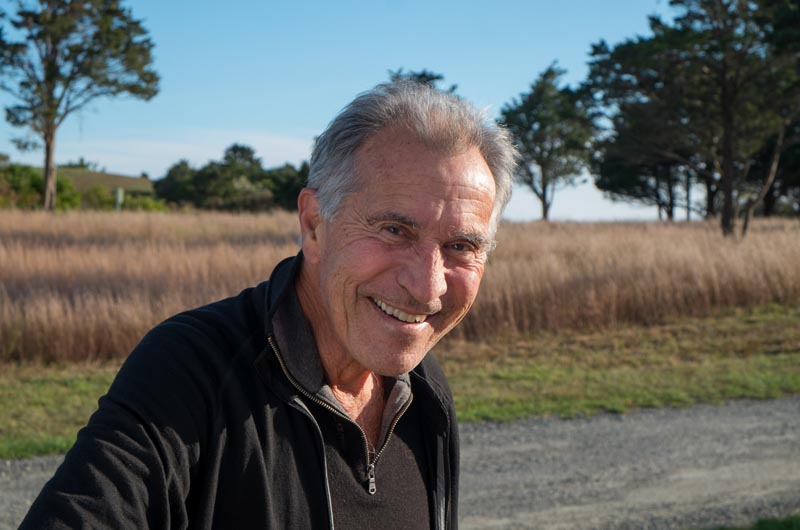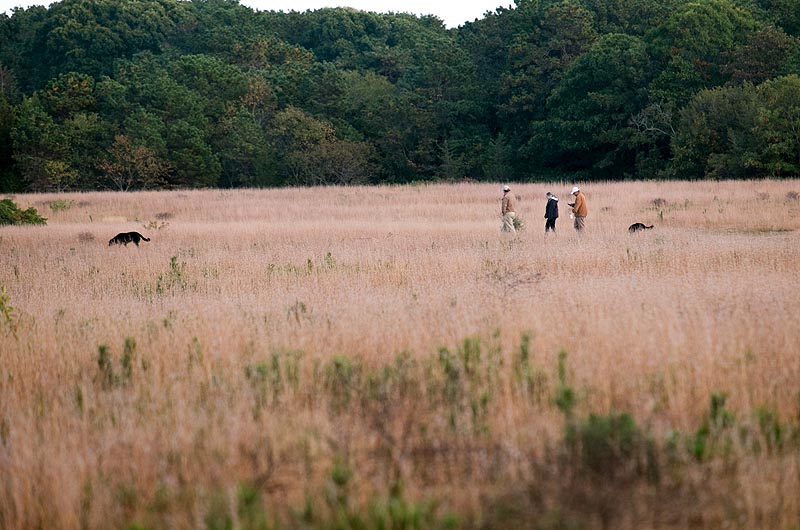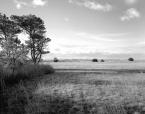Pockets of sandplain grasslands throughout the Vineyard turn a light mahogany color as the nights begin to cool in late summer. Katama Air Park in Edgartown, Trade Wind Fields Preserve in Oak Bluffs and the various fire trails that run through the Manuel F. Correllus State Forest are among the best places to take in the color.
Sandplain grasslands, which are most extensive on the Cape and Islands, as well as on Long Island, usually include a variety of grasses, wildflowers and shrubs. But it is the native grass little bluestem that creates the ochre hues in late summer and early fall, and in large part helps sustain the diversity of the grassland ecosystem.
By September little bluestem has reached its full height of about three feet, and has sent out seed heads. The flowering season lasts through November and the color lasts through most of the winter.
“By October you’ve just got a beautiful cloud of seed going on, especially when it’s backlit,” said Carlos Montoya, an Aquinnah resident who owns Native Plant Associates and specializes in seeding little bluestem meadows. Unlike other long grasses, which form carpets, little bluestem grows in clumps, which allows other species to grow around it. It is also one of the few North American plants to utilize the C4 photosynthetic pathway, which allows it to grow in dry conditions. “Once it’s established, you can virtually walk away from it,” Mr. Montoya said. “And just when everything else is turning brown, this thing is in its glory.”

Much of its habitat on the Vineyard was created by grazing animals. Open spaces in the past were also created by fire and sometimes maintained through controlled burning. But farming has decreased since the early 1900s, along with an increase in fire suppression, and most open land on the Vineyard has reverted back to forest.
“All of the habitat that requires full sun is getting smaller and smaller,” Mr. Montoya said. “And that means the gene pool, which is kind of the survival into the future — that gets constricted too, since there is less and less seed being produced. So I think it’s really important to keep the different habitats in balance.”
Mr. Montoya was involved in efforts by The Nature Conservancy and the Marine Biological Laboratory in Woods Hole to convert forested land on the Vineyard’s south shore to grassland and little bluestem beginning in 2001. As a result, the number of plant species in that area tripled from about 25 to 75 species.
Matt Pelikan, a Vineyard resident and coastal ecologist with The Nature Conservancy, said the plant also supports insect and bird species, which often prefer dispersed vegetation. “The amount of energy that is stored in little bluestem plants is pretty considerable,” he said. Some insects have life cycles tied to the little bluestem and many caterpillars feed on it exclusively. “It’s an important linchpin in the food web,” Mr. Pelikan said.
He added that because little bluestem grows late in the season, it is useful in seed mixes for farm pastures. “Then you have a mix of species that’s diverse enough so there will be something growing actively at all points in the season,” he said. “A lot of the land management that we’ve done of conservation properties has been aimed at promoting sandplain grassland habitats, and little bluestem would be one of the key species that you’d want to see be prominent in places like that.”
Another project is underway at Herring Creek Farm on the Katama plains near the airfield. On the farm field known as the east field, The Nature Conservancy and MBL began experimenting in 2007 to find the best ways to convert an agricultural grassland to a sandplain grassland with little bluestem. They began with 180 small plots and 30 different treatment methods. They expanded to a smaller number of larger plots and are now working to convert all 24 acres.
Chris Neill, director of the ecosystems center at MBL, said the most important factor turned out to be the seeding of native plants. “I actually went into this thinking that the soils would be much more important than they turned out to be,” he said. “It turns out that soils don’t really give the non-natives a big advantage.”
Two scientific papers associated with the study were recently submitted for publication.
Without as much grazing and fire, sandplain grasslands depend much more on human management than in the past. Mr. Montoya said that as sheep farming declined on the Vineyard, it gave little bluestem a temporary opening, but then other species began growing up. He said one mowing a year is all it takes to maintain an area where little bluestem has become established.
Little bluestem’s distribution in the United States also makes it somewhat unique. Although its habitat on the East Coast is limited to certain areas, it is widespread in the tall grass prairies of the central United States. Mr. Neill said its habitat likely followed the edges of the receding glaciers on either side of the Appalachian mountains during the last ice age.
Bison grazing and fire originally maintained the prairies. “Where those things were absent, the forest grew back and it squeezed little bluestem into some very small areas east of the Appalachians,” Mr. Neill said. “But west of the Appalachians it had tremendously wide distribution.”
Along with its tolerance for drought and disturbed areas, little bluestem has roots that can grow up to 10 feet long, making it potentially useful for controlling erosion. It also tends to sequester nitrogen from the air and surface, but its roots do not reach far enough underground to mitigate wastewater runoff, Mr. Neill said.
“The nice thing about a bluestem meadow is you don’t really need to fertilize it,” he added. “So that’s helpful in controlling nitrogen runoff in comparison to a more standard lawn.”
Although it is often planted in large meadows, little bluestem is not as widely used in residential landscaping. But Mr. Neill hoped the experiments at Herring Creek Farm could eventually be applied to smaller-scale and more distributed efforts to create new habitat. “That’s one of the avenues by which we can see the application of this work,” he said.








Comments (7)
Comments
Comment policy »